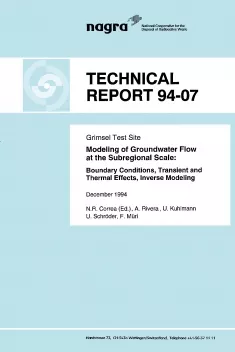
Technical Report NTB 94-07
Grimsel Test Site:Modeling of Groundwater Flow at the Subregional Scale: Boundary Conditions, Transient and Thermal Effects, Inverse Modeling
This report presents the findings of four major works developed by various work teams during the period of 1991 – 1993, under project MOD phase III.
In the scope of the hydrogeological test program, project MOD was designed to investigate the adequate strategy for the hydrodynamic modeling of groundwater flow in a fractured rock body surrounding the Grimsel Test Site (GTS). The principal goals for phase III were to: investigate strategies for model calibration and validation; quantitatively evaluate groundwater transient effects due to the presence of drifts; analyse coupled thermo-hydraulic effects with variable-density fluid around an imaginary repository. An overall aim of project MOD from its very conception was to gain experience and know-how and to create and/or adapt innovative numerical tools.
A literature review of model calibration and validation concepts, and scaling of hydrogeological parameters, allowed the elaboration of a strategy for model calibration and validation with the main conclusions from the state-of-the-art literature in this field. This methodology is applied to the sub-regional GTS model enabling an automatic calibration with the use of an inverse model. The groundwater transient effects due to the presence of drifts are evaluated quantitatively in one, two and three dimensions with analytical and numerical models. The latter exercise permits the application of complex numerical models that are tested by comparison with analytical solutions. In this case, an assorted type of boundary conditions and grid discretizations are tested in order to have a set of cases, as complete as possible, for this type of problems.
The effects of variable-density groundwater flow due to heat release from a fictitious high-level waste repository are evaluated. The numerical grid discretization needed for this type of nonlinear problem is first evaluated with the grid Peclet number criteria in three dimensions. This process-oriented study, aims at: determining the feasibility of performing 3-D coupled thermo-hydraulic computations with the available computer facilities; performing scoping thermo-hydraulic computations for a representative 3-D fictitious repository; and, comparing the resulting groundwater flow field with the isothermal flow field.
Finally, we conclude that the goals of project MOD phase III were achieved. The methodologies and tools developed during this work, as well as the modeling strategies and actual simulations give a useful framework for future site-specific hydrodynamic modeling studies within the scope of Nagra. Processes related to transient hydrodynamic effects are better understood for models in one, two and three dimensions. Automated inverse modeling has proven to be a powerful tool for model calibration. The results on the scoping of computer load and grid discretization for large problems (3D) with complex hydrogeology, and transient or coupled problems, can be used to better design future specific studies. In short, it is believed that considerable knowhow and experience have been acquired during Project MOD III with a view to understanding the hydrodynamic behaviour of low permeable heterogeneous media around underground constructions.
